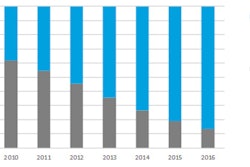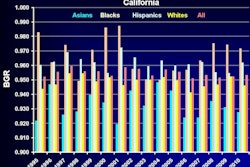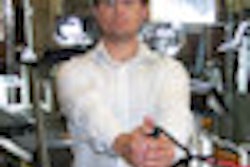Technologist-performed handheld screening breast ultrasound -- offered to women in the general population with dense breasts -- can help detect small mammographically occult breast cancers, although overall positive predictive value (PPV) is low, according to a study published online June 21 in Radiology.
Researchers from Yale University School of Medicine sought to evaluate the effect of a breast density notification law passed in Connecticut in October 2009, which requires radiologists to inform patients with mammographically dense breast tissue that they may benefit from additional screening breast ultrasound (Radiology, June 21, 2012).
"The purpose of this study was to determine the utilization and performance of screening breast ultrasound in women who presented to our breast imaging practice with dense breast tissue in the first year since the implementation of [the Connecticut] law," wrote lead author Dr. Regina Hooley and colleagues.
Hooley and colleagues included 935 women with dense breasts at mammography in the study. Each woman underwent handheld screening and whole-breast ultrasound between October 2009 and September 2010. Seven hundred fifty-three women received their breast density notification following a screening mammogram and 182 women received it following a diagnostic mammogram, Hooley's team wrote.
Of the screening breast ultrasound examinations:
- 701 (75%) results were classified as BI-RADS category 1 or 2
- 187 (20%) results were classified as BI-RADS category 3
- 47 (5%) results were classified as BI-RADS category 4
Of 63 biopsies and aspirations, three lesions were malignant (all BI-RADS 4, diagnosed with biopsy). All three cancers were smaller than 1 cm, were found in postmenopausal patients, and were solid masses. Forty-four of the 935 cases, or 4.7%, were false positives.
Hooley's group found that technician-performed handheld supplemental screening ultrasound in patients with dense breast tissue at mammography had a cancer detection rate of 3.2 cancers per 1,000 women screened. This is comparable to screening mammography alone, which has a known cancer detection rate of two to eight cancers per 1,000 women screened. Overall PPV for biopsy or aspirations performed in patients with BI-RADS 4 masses was 6.5%.
"Women with dense breast tissue at mammography who choose screening breast ultrasound should be aware of frequent false-positive results and the potential for requiring additional follow-up examinations," the authors concluded. "[But] with technologist-performed handheld screening breast ultrasound, a cancer detection rate can be achieved that is similar to that with physician-performed examinations."



















